Solutions Manual for
A Practical Introduction to
Data Structures and Algorithm
Analysis
Second Edition
Clifford A. Shaffer
Department of Computer Science
Virginia Tech
Blacksburg, VA 24061
November 30, 2000
Copyright c2000 by Clifford A. Shaffer.
�
Contents
Preface
1 Data Structures and Algorithms
2 Mathematical Preliminaries
3 Algorithm Analysis
4 Lists, Stacks, and Queues
5 Binary Trees
6 General Trees
7 Internal Sorting
8 File Processing and External Sorting
9 Searching
10 Indexing
11 Graphs
12 Lists and Arrays Revisited
13 Advanced Tree Structures
ii
1
5
17
23
32
40
46
54
58
64
69
76
82
i
�
ii
14 Analysis Techniques
15 Limits to Computation
Contents
88
94
�
Preface
Contained herein are the solutions to all exercises from the textbook A Practical
Introduction to Data Structures and Algorithm Analysis, 2nd edition.
For most of the problems requiring an algorithm I have given actual code. In
a few cases I have presented pseudocode. Please be aware that the code presented
in this manual has not actually been compiled and tested. While I believe the algo-
rithms to be essentially correct, there may be errors in syntax as well as semantics.
Most importantly, these solutions provide a guide to the instructor as to the intended
answer, rather than usable programs.
iii
�
�
1
Data Structures and Algorithms
Instructor’s note: Unlike the other chapters, many of the questions in this chapter
are not really suitable for graded work. The questions are mainly intended to get
students thinking about data structures issues.
1.1 This question does not have a specific right answer, provided the student
keeps to the spirit of the question. Students may have trouble with the con-
cept of “operations.”
1.2 This exercise asks the student to expand on their concept of an integer repre-
sentation. A good answer is described by Project 4.5, where a singly-linked
list is suggested. The most straightforward implementation stores each digit
in its own list node, with digits stored in reverse order. Addition and multi-
plication are implemented by what amounts to grade-school arithmetic. For
addition, simply march down in parallel through the two lists representing
the operands, at each digit appending to a new list the appropriate partial
sum and bringing forward a carry bit as necessary. For multiplication, com-
bine the addition function with a new function that multiplies a single digit
by an integer. Exponentiation can be done either by repeated multiplication
(not really practical) or by the traditional Θ(log n)-time algorithm based on
the binary representation of the exponent. Discovering this faster algorithm
will be beyond the reach of most students, so should not be required.
1.3 A sample ADT for character strings might look as follows (with the normal
interpretation of the function names assumed).
1
�
2
Chap. 1 Data Structures and Algorithms
// Concatenate two strings
String strcat(String s1, String s2);
// Return the length of a string
int length(String s1);
// Extract a substring, starting at ‘start’,
// and of length ‘length’
String extract(String s1, int start, int length);
// Get the first character
char first(String s1);
// Compare two strings: the normal C++ strcmp func-
tion. Some
// convention should be indicated for how to inter-
pret the
// return value. In C++, this is -
1 for s1s2.
int strcmp(String s1, String s2)
// Copy a string
int strcpy(String source, String destination)
1.4 The answer to this question is provided by the ADT for lists given in Chap-
ter 4.
1.5 One’s compliment stores the binary representation of positive numbers, and
stores the binary representation of a negative number with the bits inverted.
Two’s compliment is the same, except that a negative number has its bits
inverted and then one is added (for reasons of efficiency in hardware imple-
mentation). This representation is the physical implementation of an ADT
defined by the normal arithmetic operations, declarations, and other support
given by the programming language for integers.
1.6 An ADT for two-dimensional arrays might look as follows.
Matrix add(Matrix M1, Matrix M2);
Matrix multiply(Matrix M1, Matrix M2);
Matrix transpose(Matrix M1);
void setvalue(Matrix M1, int row, int col, int val);
int getvalue(Matrix M1, int row, int col);
List getrow(Matrix M1, int row);
�
3
One implementation for the sparse matrix is described in Section 12.3 Another im-
plementation is a hash table whose search key is a concatenation of the matrix coor-
dinates.
1.7 Every problem certainly does not have an algorithm. As discussed in Chapter 15,
there are a number of reasons why this might be the case. Some problems don’t
have a sufficiently clear definition. Some problems, such as the halting problem,
are non-computable. For some problems, such as one typically studied by artificial
intelligence researchers, we simply don’t know a solution.
1.8 We must assume that by “algorithm” we mean something composed of steps are
of a nature that they can be performed by a computer. If so, than any algorithm
can be expressed in C++. In particular, if an algorithm can be expressed in any
other computer programming language, then it can be expressed in C++, since all
(sufficiently general) computer programming languages compute the same set of
functions.
1.9 The primitive operations are (1) adding new words to the dictionary and (2) search-
ing the dictionary for a given word. Typically, dictionary access involves some sort
of pre-processing of the word to arrive at the “root” of the word.
A twenty page document (single spaced) is likely to contain about 20,000 words. A
user may be willing to wait a few seconds between individual “hits” of mis-spelled
words, or perhaps up to a minute for the whole document to be processed. This
means that a check for an individual word can take about 10-20 ms. Users will
typically insert individual words into the dictionary interactively, so this process can
take a couple of seconds. Thus, search must be much more efficient than insertion.
1.10 The user should be able to find a city based on a variety of attributes (name, location,
perhaps characteristics such as population size). The user should also be able to in-
sert and delete cities. These are the fundamental operations of any database system:
search, insertion and deletion.
A reasonable database has a time constraint that will satisfy the patience of a typical
user. For an insert, delete, or exact match query, a few seconds is satisfactory. If the
database is meant to support range queries and mass deletions, the entire operation
may be allowed to take longer, perhaps on the order of a minute. However, the time
spent to process individual cities within the range must be appropriately reduced. In
practice, the data representation will need to be such that it accommodates efficient
processing to meet these time constraints. In particular, it may be necessary to sup-
port operations that process range queries efficiently by processing all cities in the
range as a batch, rather than as a series of operations on individual cities.
1.11 Students at this level are likely already familiar with binary search. Thus, they
should typically respond with sequential search and binary search. Binary search
should be described as better since it typically needs to make fewer comparisons
(and thus is likely to be much faster).
1.12 The answer to this question is discussed in Chapter 8. Typical measures of cost
will be number of comparisons and number of swaps. Tests should include running
timings on sorted, reverse sorted, and random lists of various sizes.
�
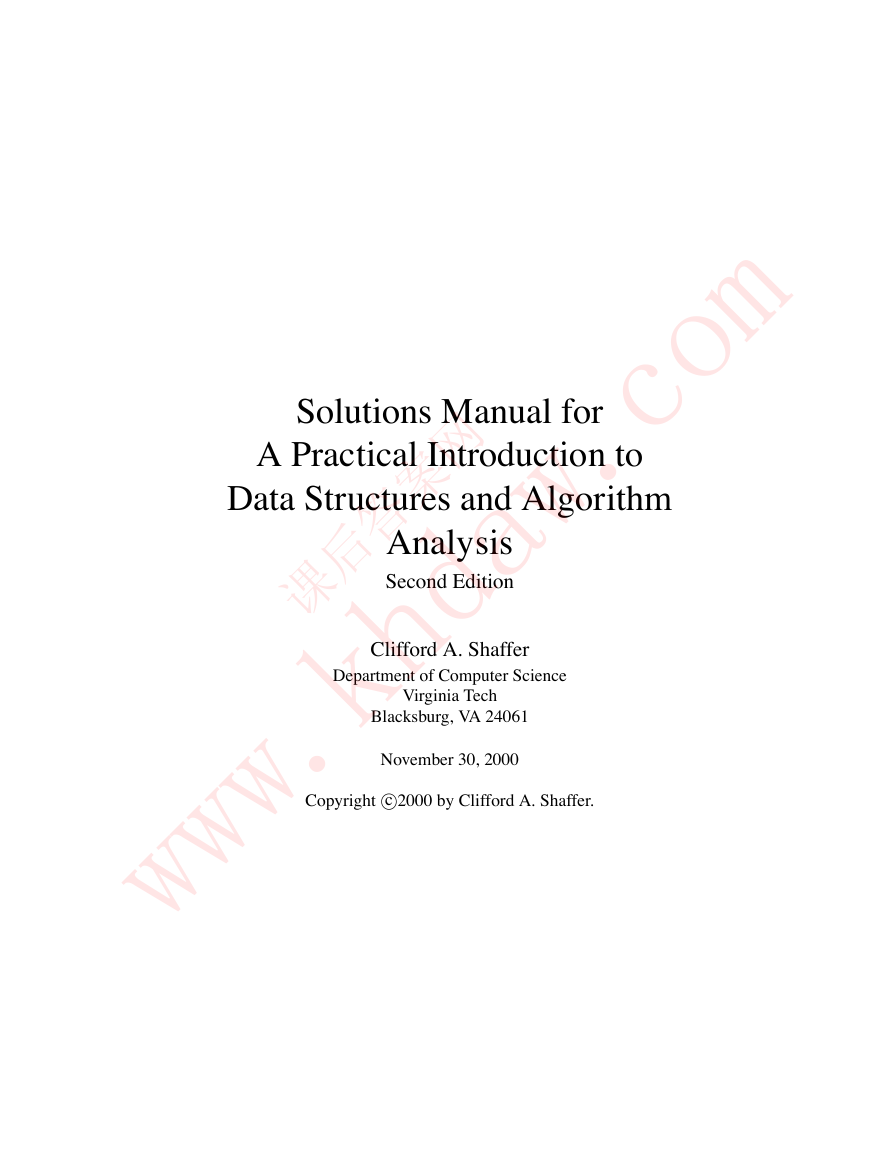
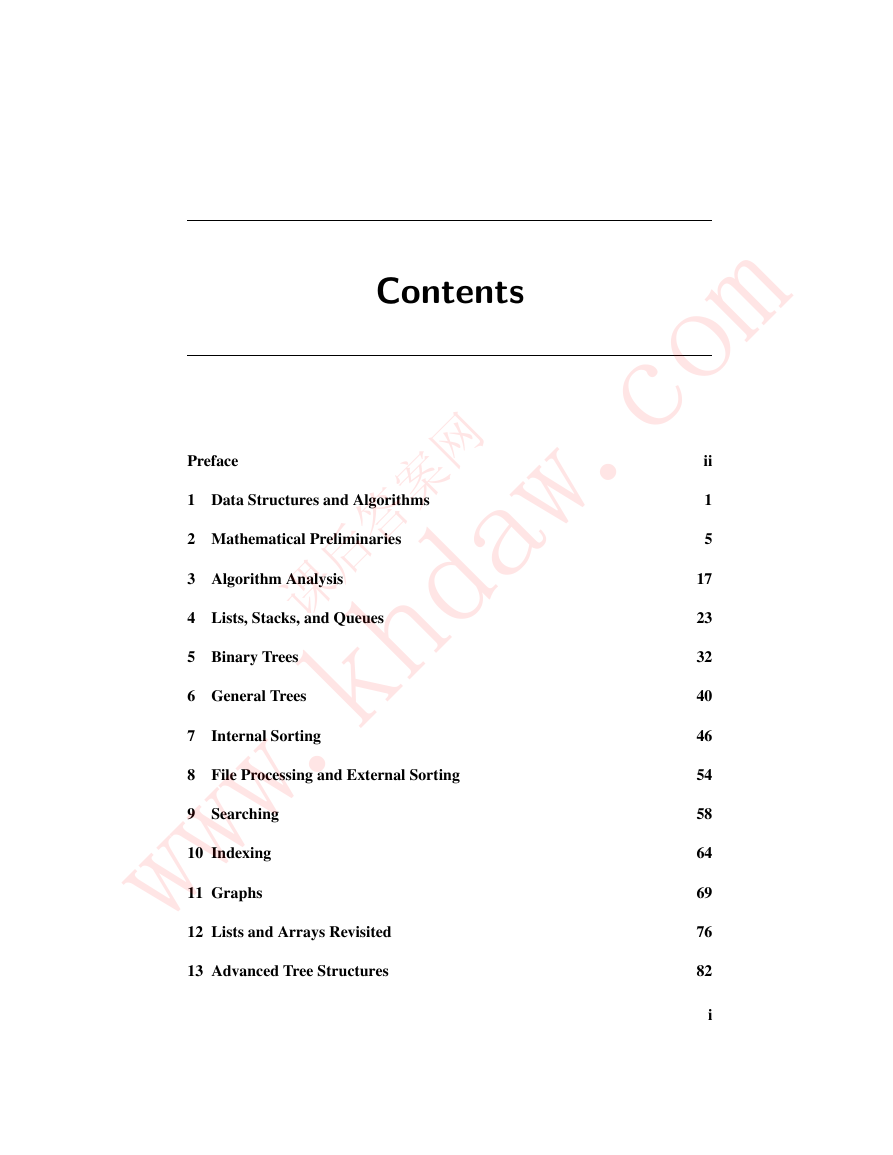
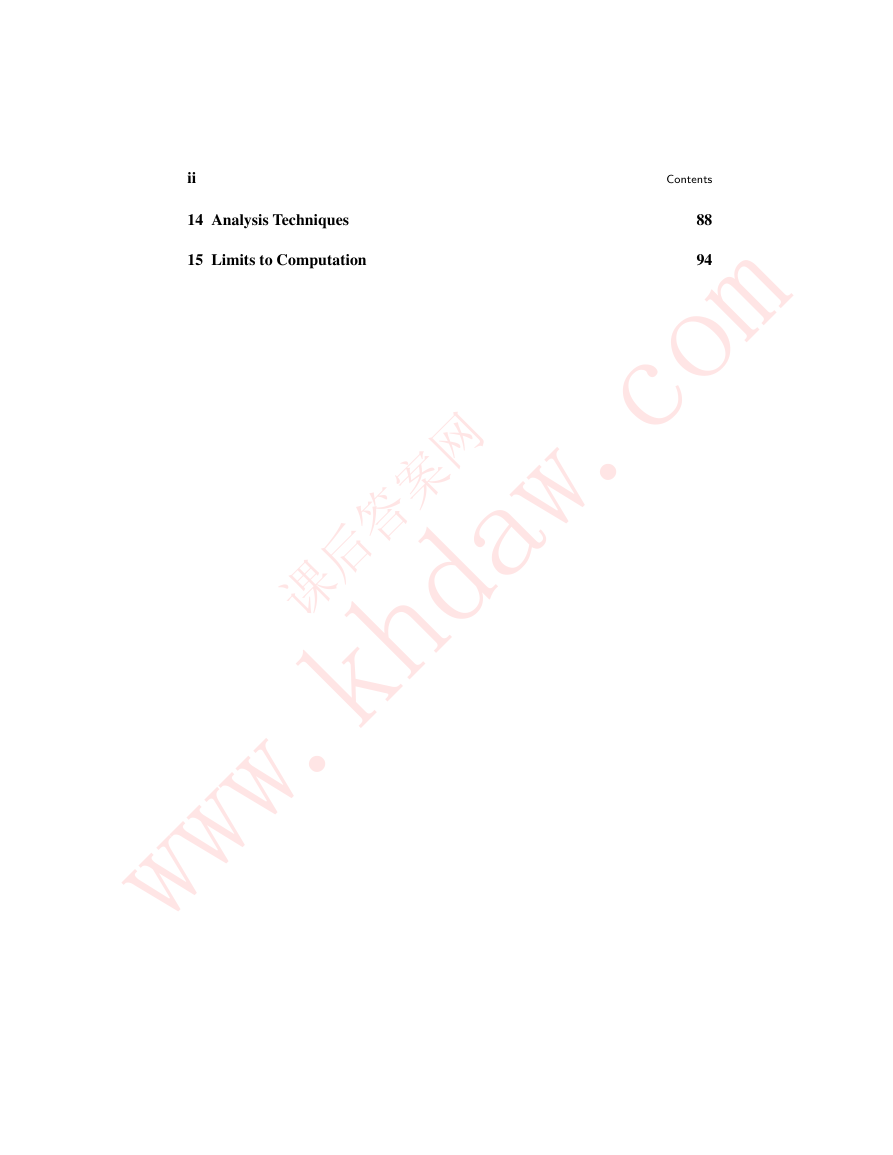
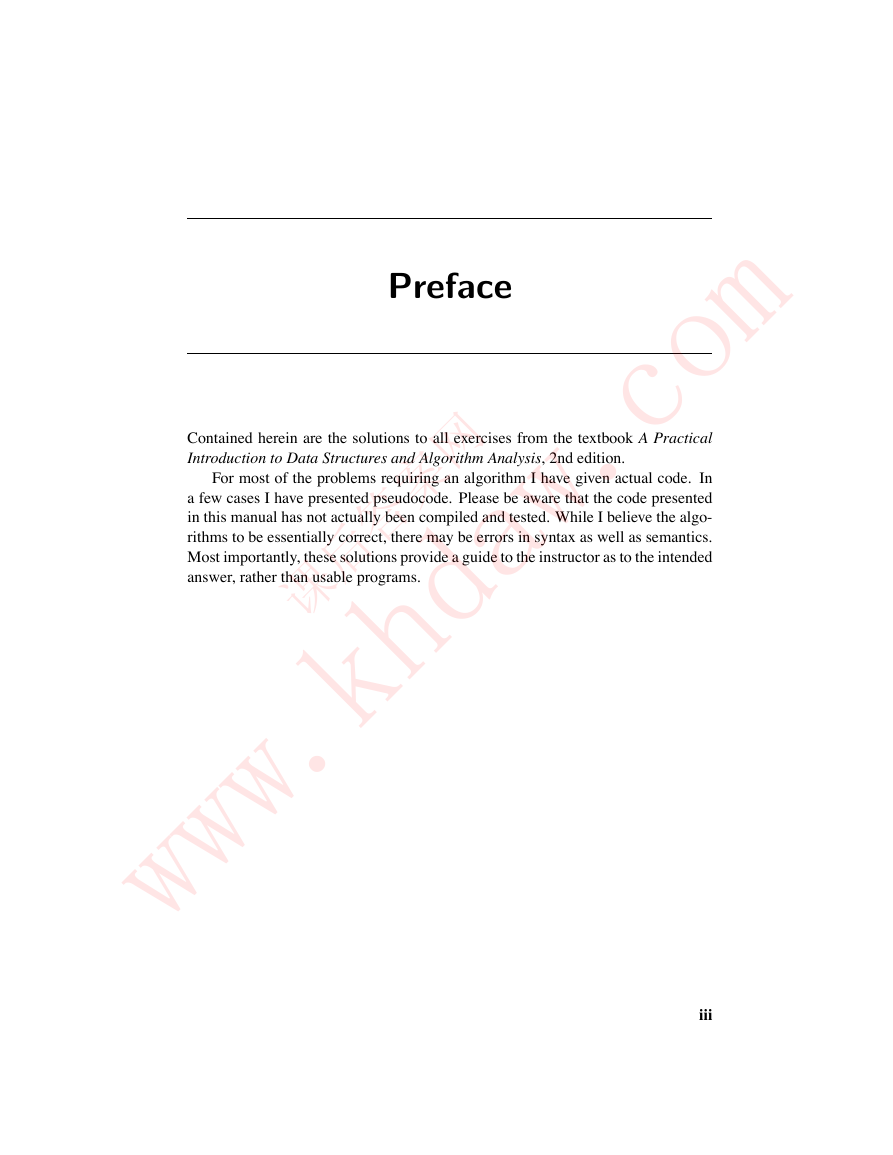


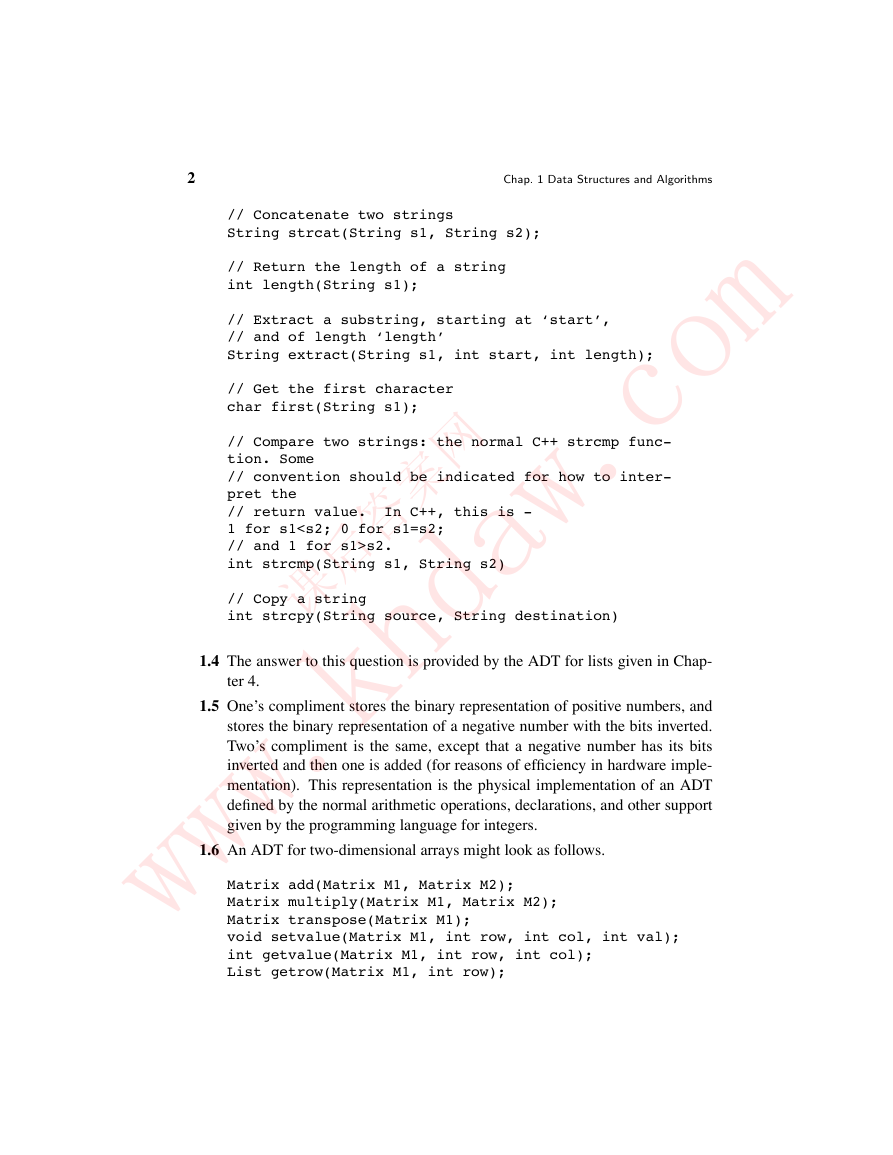
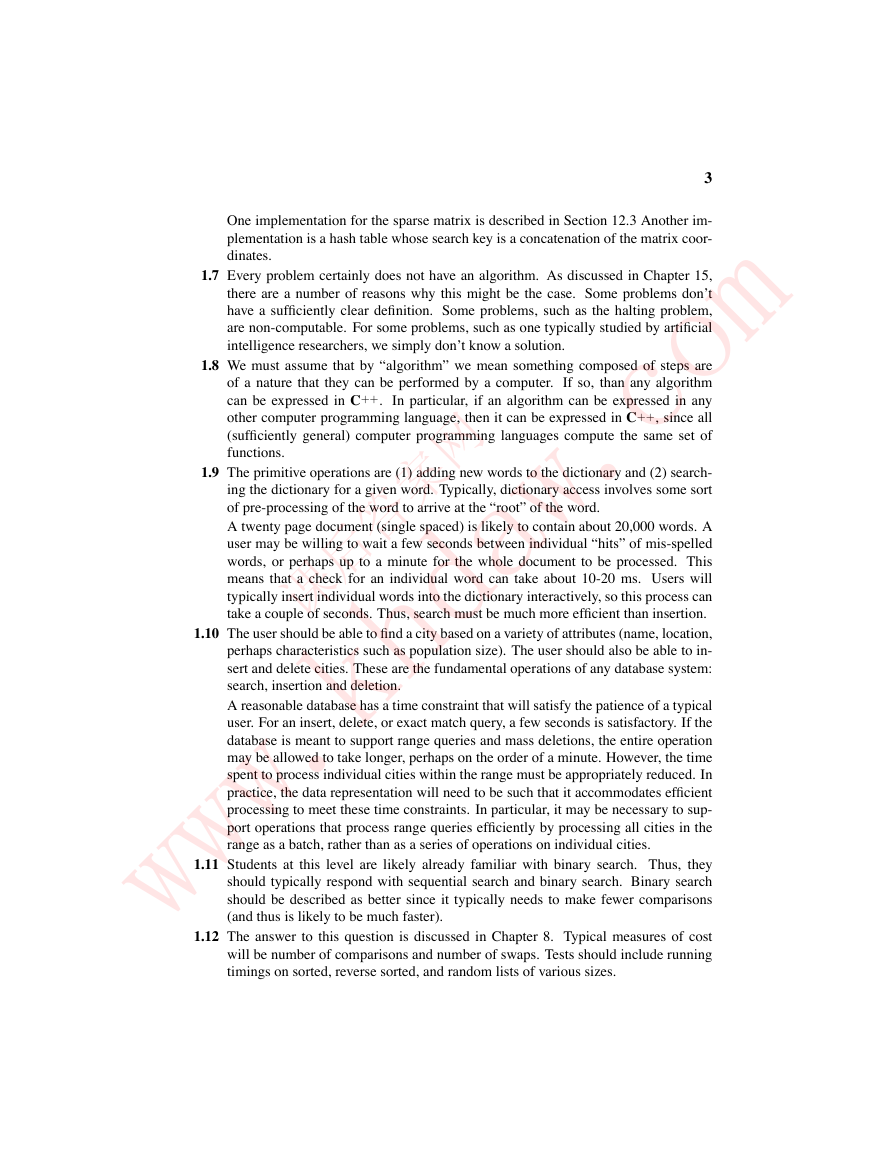








 2023年江西萍乡中考道德与法治真题及答案.doc
2023年江西萍乡中考道德与法治真题及答案.doc 2012年重庆南川中考生物真题及答案.doc
2012年重庆南川中考生物真题及答案.doc 2013年江西师范大学地理学综合及文艺理论基础考研真题.doc
2013年江西师范大学地理学综合及文艺理论基础考研真题.doc 2020年四川甘孜小升初语文真题及答案I卷.doc
2020年四川甘孜小升初语文真题及答案I卷.doc 2020年注册岩土工程师专业基础考试真题及答案.doc
2020年注册岩土工程师专业基础考试真题及答案.doc 2023-2024学年福建省厦门市九年级上学期数学月考试题及答案.doc
2023-2024学年福建省厦门市九年级上学期数学月考试题及答案.doc 2021-2022学年辽宁省沈阳市大东区九年级上学期语文期末试题及答案.doc
2021-2022学年辽宁省沈阳市大东区九年级上学期语文期末试题及答案.doc 2022-2023学年北京东城区初三第一学期物理期末试卷及答案.doc
2022-2023学年北京东城区初三第一学期物理期末试卷及答案.doc 2018上半年江西教师资格初中地理学科知识与教学能力真题及答案.doc
2018上半年江西教师资格初中地理学科知识与教学能力真题及答案.doc 2012年河北国家公务员申论考试真题及答案-省级.doc
2012年河北国家公务员申论考试真题及答案-省级.doc 2020-2021学年江苏省扬州市江都区邵樊片九年级上学期数学第一次质量检测试题及答案.doc
2020-2021学年江苏省扬州市江都区邵樊片九年级上学期数学第一次质量检测试题及答案.doc 2022下半年黑龙江教师资格证中学综合素质真题及答案.doc
2022下半年黑龙江教师资格证中学综合素质真题及答案.doc